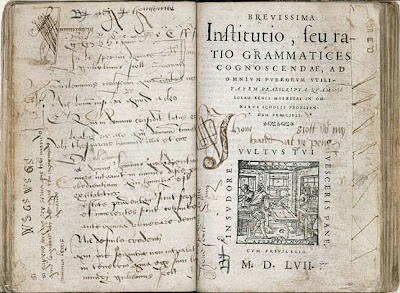Folger-GW Undergraduate Research Seminar 2007: A Report from the Instructor, Sarah Werner
This past fall saw the inaugural class of the Folger-GW Undergraduate Research Seminar. Focused on “Books and Early Modern Culture,” the seminar is the first offering of the new Undergraduate Program at the Folger Shakespeare Library. The seminar was developed with the support of the Dean’s office of the Columbian College of Arts and Sciences at The George Washington University, with the purpose of offering to exceptional undergraduate huma nities students the opportunity to conduct advanced-level independent research. Eight students successfully applied for admission to the seminar, all seniors and coming from majors in English, History, French, and Music. The course introduced students to the roles that printed books played in Renaissance society; it also allowed students to become Readers at the Folger, a privilege that is usually extended only to Ph.D. students and faculty.
nities students the opportunity to conduct advanced-level independent research. Eight students successfully applied for admission to the seminar, all seniors and coming from majors in English, History, French, and Music. The course introduced students to the roles that printed books played in Renaissance society; it also allowed students to become Readers at the Folger, a privilege that is usually extended only to Ph.D. students and faculty.
I had the great pleasure of teaching the course this fall. One of the rewards of this work has been the opportunity to discover items in the Folger’s substantial collection. Because my research usually focuses on modern productions of Shakespeare, I rarely need to look at early modern books. But my first loves were Milton’s Paradise Lost and Philip Sidney’s and Mary Wroth’s sonnet sequences, so to have an excuse to go back into the archives was delightful.
Part of the thrill of rare books is seeing traces of their readers. We are lucky that when the Folgers were building their collection, they valued marked-up copies of books. Many collectors of their era preferred books to be “clean” rather than “dirty” (what a way to refer to readers’ marginalia!), and collectors would not only try to buy books that had not been written in, but they would even bleach and trim pages so as to rid them of readers’ marks. William Lily’s A short introduction of grammar was the standard Latin textbook in the period, and this copy bears witness to the many students who used it not only to learn Latin, but to practice writing their alphabet. You can see one owner’s inscription just above the woodcut on the titlepage: “Jhone Scott with my hand at the pene.”
Other books are more carefully inscribed, one owner’s name after another, often tracing its descent through a single family. This copy of a 1550 printing of The workes of Geffray Chaucer bears inscriptions of a number of former owners, including Frances Wolfrestron, a seventeenth-century book collector who often marked her books. This one is signed, “Frances Wolfresston her bouk given her by her motherilaw mary wolfreston.” When Frances Wolfreston died in 1677, she willed her collection to her son; our copy has three other signatures from the Wolfreston family, and the Folger has other books from her collection as well. Wolfreston might be the most notable collector’s signature in this book, but its other owners took equal care in inscribing their names. The second image on the right shows verses signed by Dorothy Egerton and the inscription of one of her descendents, Anne Vernon.
But perhaps my favorite recent discovery from our rare materials collection is a beautiful 1928 edition of Hamlet by Cranach Press. It’s a wonderful example of the book arts movement, with type and woodcuts made specifically for this printing. The book prints a German translation of Shakespeare’s play, surrounded by excerpts from source materials of the Hamlet story from Belleforest and Saxo Grammaticus and incorporating woodcuts by Edward Gordon Craig. The play is not simply illustrated, however. The woodcuts and the page layout work together to tell the story of the play. The opening pages show beautifully this interplay, with the guards leaning up against the “W” from the play’s opening lines, “Wer da?” The most striking moment comes at the report of Ophelia’s death, which is illustrated by a rectangle of pale blue with an isolated figure standing within it. It’s the only place in the book where the color blue is used, and when you turn the page and see the image, the sadness and isolation of her death hits home. It is an astoundingly moving example of how typography, color, and illustration—the mise-en-page—can affect a reader more profoundly than words alone.
— Sarah Werner, Folger Shakespeare Library (swerner@folger.edu)
